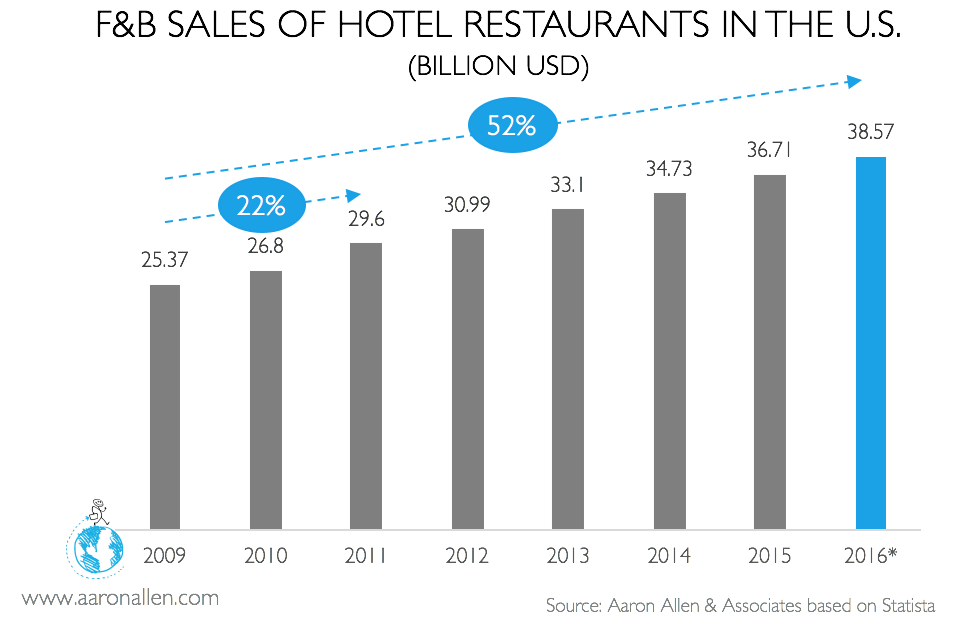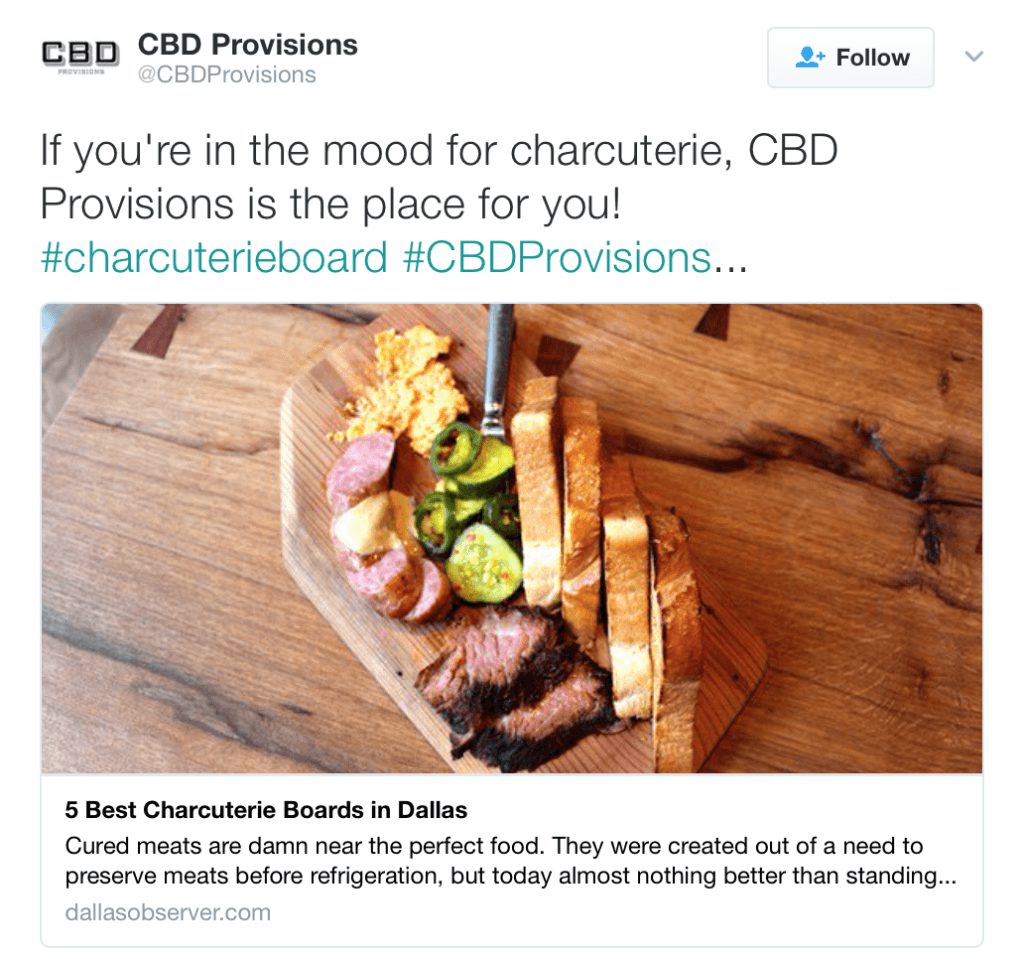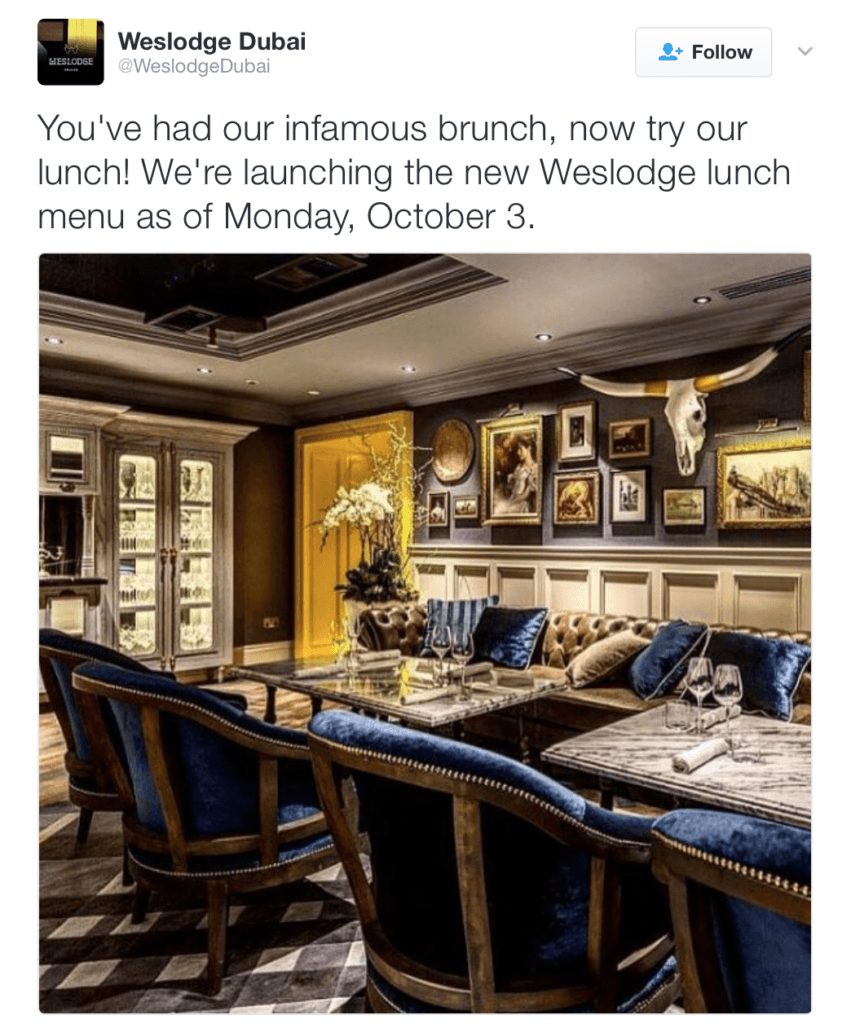Hotel food and beverage trends historically haven’t been on the cutting edge. For the most part, they’re still not forecasting trends so much as they are responding to them. The rise of healthier options certainly isn’t a surprise, considering “natural” and “fresh” have been the most bankable words in food for quite some time now. And with urbanization leading to an increased number of food ATMs and automats in major cities around the globe, “on-the-go” options have been booming in other segments long before they made their way to hotel lobbies. Still, some industry players are making moves away from the traditional sub-par in-room or on-site dining experience — taking a page out of the traditional restaurant industry in an attempt to woo guests and locals alike.
It’s hard to separate a hotel from its food and beverage offerings. In fact, a 2014 Hotels.com survey found that guests count food (complimentary breakfast and on-site restaurant) among the top two amenities when selecting a hotel. So it’s perhaps unsurprising, then, that F&B sales at U.S. hotel restaurants continue to climb year after year.

These days, hotel dining has broken away from its traditional necessary evil/loss leader status. Many middle-of-the-road operators still cling to old, ho-hum concepts, but boutique hotels and forward-thinking chain operators have reimagined lodging food and beverage (F&B) offerings to suit the tastes and lifestyle preferences of today’s traveler. In the bargain, they’ve engaged locals, too — which has long been a key to survival for hotel-based restaurants and hotel food and beverage in general.
Here are some hotel food and beverage trends that have disrupted the accommodation industry.
1. KITCHENS MOVE OUT FRONT

Open kitchens are nothing new for upscale eateries, but until recently they haven’t been a staple at hotels. That’s changed, and has brought new life to many a dining room. The staff at the newly opened Catalina Kitchen at the Terranea Resort in Rancho Palos Verdes, for instance, show off their skills at open stations including a raw bar, grill station and pizza oven.
The hottest seat in the house at Miller’s Guild in Seattle’s Hotel Max is at a chef’s table overlooking a massive wood-fired grill that serves as the focal point of the restaurant, which is outfitted with custom furnishings crafted by local carpenters, metal workers, and masons. The lucky 10 diners who land a seat there get a front-row seat for award-winning chef Jason Wilson’s magic show.
At the Marriott City Center in Charlotte, N.C., a recent makeover of the lobby introduced three new F&B concepts: A bar featuring cocktails prepared in a French press; a signature coffee shop, and Stoke Restaurant, with sleek tables arranged around an open kitchen with a wood-burning oven. Cooks in the restaurant at times personally deliver plates to tables, and the design is deliberately meant to create a dialogue between guests and the kitchen. The three concepts are reportedly a test model for other Marriotts.
2. LOCAL TASTES CONNECT WITH LOCALS AND TRAVELERS

Following the lead of many Las Vegas hotels, owners and management companies in other cities rushed to bring celebrity chefs on board to create a buzz for their properties. That gamble hasn’t always paid off; today you’re more likely to see a hometown name manning the kitchen, often creating familiar dishes that reflect local favorites. With more travelers seeking out authentic experiences and tastes, and with a built-in fan base from local residents, that’s a smart strategy.
At the Joule Hotel in Dallas, CBD Provisions took over the space once occupied by Charlie Palmer Steak. Out went formality and big cuts of beef, in came a rustic Wild West/big city brasserie look and a menu that focuses on Texas products, including Gulf seafood, pork tacos, and local craft beers.
Two of Chicago’s most celebrated chefs — Paul Kahan and chef Erling Wu-Bowerm — created Nico Osteria at the Thompson Hotel in the Windy City, to spotlight ingredients from local farmers and nearby Green City Market.
There remains a largely untapped opportunity to wow foodie guests with chef-inspired room service. At the Public Hotel in Chicago, Jean-Georges Vongerichten’s reimagined Pump Room kitchen handles the honors, delivering food in a brown bag hung from the doorknob within 10 minutes of ordering. The menu includes to-go options for guests checking out as well.
3. ON-THE-GO ALSO BECOMES A HOTEL F&B TREND
This is one of the hotel food and beverage trends that has been taken from the foodservice industry in general. Snacking is eroding regular meal schedules, and mobile lives are pushing consumers to seek out something quick and portable (urbanization is partly to blame for that, which we’ve discussed in the past). Limited-service hotels have long been equipped with a pantry stocked with snacks, beverages, and simple meals near the front desk, but their full-service counterparts are getting in on the retail action with their own more elaborate versions.
One of the latest is the sprawling Central Pantry, which opened late last year as one of a half-dozen dining options at the world’s largest hotel, the Orlando World Center Marriott. Open from 6 a.m. to 2 a.m., it’s got something for every taste and appetite, from grab-and-go snacks to fresh bakery items, salads, gourmet flatbreads, coffee, smoothies, craft beer and wine on tap or in bottles, frozen yogurt, and carbonated drinks. A communal seating area is built into the space. The hotel also offers a Fresh Bites all-day menu of reasonably priced takeout snacks and meals—very similar to the Central Pantry selections—that can be delivered to a guestroom or picked up within 25 minutes or less. It’s a much more compelling product than your run-of-the-mill roomservice.
4. BETTER BREAKFASTS AND BETTER COFFEE ABOUND
If hotel guests are going to eat one meal on the property, it’s probably going to be breakfast. One study found that 70% of U.S. leisure travelers consider getting a free breakfast included with the room rate as “extremely or very influential” in their selection of a hotel or resort. Business travelers concur: 63% of them say a free breakfast is “extremely or very desirable” when they choose a hotel or resort. Many hotels do a decent job with breakfast, but the proliferation of Starbucks, Panera, and other coffee shops and bakery cafes has put pressure on hotels to up their game.
At the Hyatt Regency Huntington Beach in California, breakfast reflects the latest trends on Pinterest and Instagram: Instead of boring oatmeal and eggs over easy, guests can choose from smoothies, breakfast parfaits, superfoods-packed bowls and eye-catching chia pudding pots served in mason jars topped with berries and edible flowers.
The Marriott City Center’s coffee/lunch/bakery concept, Coco and the Director, sports 30-foot ceilings, loft seating, free wi-fi, and reservable meeting space. A Sandwich of the Day is revealed on social media every morning and when it’s sold out, it’s sold out. Coco and the Director is angling not just for the guest but for locals seeking a decent caffeine jolt in a cool third space.
5. GOOD-FOR-YOU OPTIONS ARE GROWING AMONG HOTEL FOOD AND BEVERAGE TRENDS

At one time, steakhouses ruled for business travelers—especially men, freed from the constraints of their healthy-ish dinners at home, who yearned to feed their inner carnivore. But younger and increasing numbers of health-conscious travelers, both men and women, are changing that. Brands like EVEN Hotels, from InterContinental Hotels Group, have been launched to make this group happy. EVEN’s stated mission is to help travelers “Eat Well, Rest Easy, Keep Active and Accomplish More.”
Eating well at EVEN means a menu at Cork & Kale Market and Bar that accommodates paleo, vegan/vegetarian, low-fat and gluten-free diets; organic and natural beers and wines; freshly squeezed juices; and healthy options for grab-and-go and pre-ordered meals.
6. RESTAURANT DESIGNS TAKE CUES FROM RESIDENTIAL

Sixty-eight floors above Dubai, the 11,000-square-foot Weslodge in the JW Marriott Marquis is tricked out like a private residence. Satin lacquer panels and textured wallcoverings, more than 150 individual works of art, hand-selected antiques, trophy animal heads, weathered oak floors, tufted leather seating, and area rugs are distributed throughout the space, evoking a very eclectic and well-appointed manor or clubhouse.
Sheraton, Marriott, and Westin lobbies are being transformed into communal areas with casual, non-traditional furnishings and workspaces with snacks and wi-fi. They also incorporate wine bars, great coffee and snacks to encourage lingering.
They might not look exactly like a residential living room, but brands geared to Millennials and Generation Z have designed informal food and beverage spaces with hanging out in mind. Moxy, a young brand from Marriott, is designed with an informal breakfast bar that doubles as a “day bar” later in the day, offering naan-based sandwiches, cocktails, local beers, and “attentively sourced wines.” Food is served on metal trays and the space is filled with comfy sofas, ottomans, and other casual seating.
CONSUMER TRENDS CONTINUE TO FUEL HOTEL F&B
Already, we’re seeing restaurant chains invest in mobile, digital, social, and technologies that can help with everything from driving revenue to cutting costs and enhancing the guest experience. Which, come to think of it, all sound like things the hotel industry could use to great effect.
Like the traditional restaurant industry, Hotel F&B is being reshaped by powerful forces (expect delivery to play a major role moving forward, for instance). There are plenty of Hotel F&B mistakes being made as well. Some savvy companies are responding — though, similar to some pockets of the restaurant world, many seem to be lagging behind. In the near future, technological advances will force the industry to move a little faster in their response to trends.
* * *
GLOSSARY OF HOTEL FOOD AND BEVERAGE TERMS
Advance fees: discounted room prices to incentivize booking in advance.
Amenities: services or features provided to guests, including internet, swimming pools, parking, food and drink on site, spa, etc.
Average Published Rate (APR): the average room rate, considering all types of rooms; it can also be presented by season.
Average Daily Rate (ADR): Calculated as total rooms revenue divided by occupied room nights.
Average Length of Stay (ALOS): the average number of nights guests stay in the hotel.
Banquet: food served for a large number of people, usually celebrating a wedding, Bar Mitzvah, engagement, etc.
Central Reservation System (CSR): software used to hold the information on hotel availability, reservations, rates, etc. and manage bookings.
Cost per Occupied Room (CPOR): it’s calculated diving the total hotel operational cost by the number of occupied rooms.
F&B: food and beverage. Hotels provide food in restaurants, vending machines and convenience stores, mini bars, room service, etc.
Hotel Occupancy: Calculated as occupied room nights divided by available room nights.
Revenue per Available Room (RevPAR): Calculated as room revenue divided by available room nights.
ABOUT AARON ALLEN & ASSOCIATES:
Aaron Allen & Associates is a leading global restaurant industry consultancy specializing in growth strategy, marketing, branding, commercial due diligence for emerging restaurant chains and prestigious private equity firms. Aaron has personally lead boots-on-the-ground assignments in 68 countries for clients ranging from startups to multinational companies posting in excess of $37 billion. Collectively, his clients around the globe generate over $200 billion annually and span six continents and more than 100 countries.

